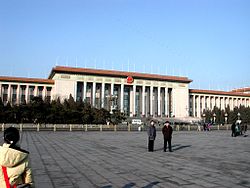China introduces new jury trial system
Sunday, May 1, 2005

The People's Republic of China (PRC) in recent years has begun an effort to reform its judicial system and make trials more fair and accountable, according to its state-run People's Daily. Those efforts came to a head today with the official May 1 start of jury duty by more than 27,000 newly qualified jurors. According to People's Daily, "It is the first time in Chinese history that the people's juries are appointed in a uniformed way by the people's congresses at all levels."
Two jurors and a judge will be sitting on each three-person panel, and decide both criminal and civil cases. The juries will be available when requested by litigants and also in cases "with considerable social repercussions", which appears to mean major cases. Appeals cases will be heard only by judges.
The jurors are not chosen for each trial but will serve a five-year term in the jury pool working on different cases from time to time.
Jurors have been provided for in the Chinese Constitution since 1954, but their role in the system was not well-defined by law until now.
The changes to the jury system are part of a long-term planned reform of China's judicial system that was announced in 1999 by China's top judge, Xiao Yang. In addition to jury reforms, the plan addressed trial procedures and court structure and supervision. The goal was to "perfect the socialist judicial system with Chinese characteristics...in accordance with the Constitution and laws, and [without] judicial independence and supremacy, which exist in many Western countries," according to Xiao Yang as reported by the People's Daily in 1999.
"Court reform represents a major part of China's reform of the judicial system and political restructuring. The essence of judicial reform is judicial fairness, which is crucial to the country's rule of law," Xiao Yang said back then.
In August 2004, the 10th National People's Congress (NPC) Standing Committee approved a "resolution on improving the people's jury system", which took effect today. The system specifies that either by recommendation of local work units or by self-application, potential jurors can take qualifying examinations and be presented to standing committees of the NPC for appointment as jurors.
The first batch of 1,342 jurors were tested in Beijing under the new law on April 23, 2005. Those who were certified to begin service on May 1 are said to "participate in all hearing activities of people's courts according to the law, enjoying the same rights as do the judges except that for a presiding judge after their assumption of the post," according to the People's Daily.
"This is an important move to upgrade and strengthen the system of people's jurors," Xiao Long of Beijing People's Court said to China Daily on April 24. "The implementation of the NPC's decision will add more transparency and justness to the country's judicial system," he added.
China has one of the world's largest prison systems with over 1 million prisoners, similar to Russia. It has received criticism over the years from the U.S. State Department and others for its arbitrariness and its treatment of political prisoners. The United States, however, is the world's largest jailer, with a staggering 2 million prison inmates, out of 9 million total around the entire globe. A full 70% of U.S. prison terms are drug-related.
Sources
[edit]- "27,000 people's juries into court with same right as judges" — People's Daily Online, April 30, 2005
- "China gives juries bigger say in reaching verdicts" — Reuters, April 25, 2005
- "Jurors to help decide court verdicts" — China Economic Net, April 25, 2005
- "Over 1000 jurors in Beijing passed through examination" — People's Daily Online, April 25, 2005
- "China Maps Out Judicial Reform" — People's Daily (China), August 6, 1999
